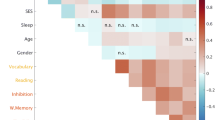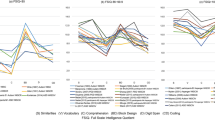Abstract
Introduction
Several studies in animals and humans have clearly demonstrated the effect of ID on development, cognition, behavior and neurophysiology. The effect of ID have been shown: on brain metabolism, neurotransmitter function, and myelination. Changes in brain iron content caused by early ID in animals are not reversible by iron therapy, inspite of correction of anemia and other tissue deficits and result in changes in behavior which continue into adulthood. ID has repercussions in the perinatal period, infancy and childhood. Some effects are irreversible while other defects may be corrected: timing of ID in a child may be critical.
Developmental Deficits
Children (6–23 months) with moderate to severe anemia (ID) or chronic anemia (>3 months) had lower mental and psychomotor development scores than the nonanemic, and except for some continued to have lower scores in spite of iron therapy for 3 months although anemia was corrected. The deficits persisted on re-evaluation at 5, 11–14, and at 19 years.
Scholastic Achievement
Scholastic achievement is lower and ID children are twice more likely to have problems with mathematics. Ten year follow-up indicated special educational assistance was required for initially anemic children. ID affects WICS items of information, comprehension and verbal performance and full scale IQ. EEG power spectrum had a slower activity suggesting developmental lag compared to iron sufficient children. Treatment with iron improved IQ scores significantly; other studies found differential effects: improvement in cognition and mental scores in older but not in younger children. IQ levels are affected by ID: IQ at 4 years may be predicted by hemoglobin at 5 and 36 months.
Neurophysiological Deficits
Abnormal Evoked Response Potentials (ERPs):ABRs and VEPs are seen in ID, which persist in children who were anemic in infancy on retesting at 4 years. Differences have been consistently found in ID infants and in older children. Iron supplementation may significantly reduce latencies of some ERPs. ID affects newborn temperament, ERPs and recognition memory. Iron supplementation in infants (<1,301 g) improved neurocognitive and psychomotor development by 5.3 years (median age). Preventive iron supplementation in well nourished infants also show a positive effect on motor development. The changes are usually subtle, however, with prevalence of anemia of 79.2% in children 6–35 months and 57.9% in pregnant women (NFHS-3, 2005–06), the adverse effects of cognitive, development and behavioral defects should not be underestimated.
Similar content being viewed by others
References
Andrews NC. Disorders of iron metabolism and sideroblastic anemia. In: Nathan DG, Orkin SH, Ginsburg D, Look AT, editors. Nathan and Oski’s hematology of infancy and childhood. 6th ed. Philadelphia: WB Saunders; 2001. p. 1.
Youdim MB, Ben-Shachar D. Minimal brain damage induced by early iron deficiency: modified dopaminergic neurotransmission. Isr J Med Sci. 1987;23:19–25.
Connor JR. Iron acquisition and expression of iron regulatory protein in the developing brain: manipulation by ethanol exposure, iron deprivation and cellular dysfunction. Dev Neurosci. 1994;16:233–47.
de los Monteros AE, Korsak RA, Tran T, Vu D, de Vellis J, Edmond J. Dietary iron and the integrity of the developing rat brain: a study with the artificially-reared rat pup. Cell Mol Biol (Noisy-le-grand). 2000;46:501–15.
Lozoff B, Beard J, Connor J, Felt B, Georgieff M, Schallert T. Long lasting neural and behavioral effects of iron deficiency in infancy. Nutr Rev. 2006;64:534–91.
Taneja V, Mishra KP, Agarwal KN. Effect of maternal iron deficiency on GABA shunt pathway of developing rat brain. Indian J Exp Biol. 1990;28:466–9.
Youdim MB, Ben-Shachar D, Yehuda S. Putative biological mechanisms of the effect of iron deficiency on brain biochemistry and behavior. Am J Clin Nutr. 1989;50:607–15.
Shukla A, Agarwal KN, Chansuria JP, Taneja V. Effect of latent iron deficiency on 5-hydroxytryptamine metabolism in rat brain. J Neurochem. 1989;52:730–5.
Erikson KM, Pinero DJ, Connor JR, Beard JL. Regional brain iron, ferritin and transferrin concentrations during iron deficiency and iron repletion in developing rats. J Nutr. 1997;127:2030–8.
Kwik-Uribe CL, Golub MS, Keen CL. Chronic marginal iron intakes during early development in mice alter brain iron concentrations and behaviour despite postnatal iron supplementation. J Nutr. 2000;130:2040–8.
Lozoff B, Brittenham GM, Wolf AW, McClish DK, Kuhnert PM, Jimenez E, et al. Iron deficiency anemia and iron therapy effects on infant developmental test performance. Pediatrics. 1987;79:981–95.
Walter T, De Andraca I, Chadud P, Perales CG. Iron deficiency anemia: adverse effects on infant psychomotor development. Pediatrics. 1989;84:7–17.
Oski FA, Honig AS, Helu B, Howanitz P. Effect of iron therapy on behavior performance in nonanemic, iron-deficient infants. Pediatrics. 1983;71:877–80.
Walter T. Effect of iron-deficiency anaemia on cognitive skills in infancy and childhood. Baillières Clin Haematol. 1994;7:815–27.
Idjradinata P, Pollitt E. Reversal of developmental delays in iron-deficient anaemic infants treated with iron. Lancet. 1993;341:1–4.
Ortega RM, González-Fernández M, Paz L, Andrés P, Jiménez LM, Jiménez MJ, et al. Influence of iron status on attention and intellectual performance of a population of Spanish adolescents. Arch Latinoam Nutr. 1993;43:6–11.
Halterman JS, Kaczorowski JM, Aligne CA, Auinger P, Szilagyi PG. Iron deficiency and cognitive achievement among school-aged children and adolescents in the United States. Pediatrics. 2001;107:1381–6.
Watkins WE, Pollitt E. Iron deficiency and cognition among school-age children. A Joint Publication of Pan American Health Organization, WHO, The World Bank and Tropical Metabolism Research Unit, Jamaica. Washington: Pan American Health Organization; 1998. p. 179–97.
Deinhard A, Gilbert A, Dodds M, Egeland B. Iron deficiency and behavioral deficits. Pediatrics. 1981;68:828–33.
Johnson DL, McGowan TJ. Anemia and infant behavior. Nutr Behav. 1983;1:185–92.
Seshadri S, Gopaldas T. Impact of iron supplementation on cognitive functions in preschool and school-aged children: the Indian experience. Am J Clin Nutr. 1989;50:675–86.
Otero GA, Aguirre DM, Porcayo R, Fernandez T. Psychological and electroencephalographic study in school children with iron deficiency. Int J Neurosci. 1999;99:113–21.
Agaoglu L, Torun O, Unuvar E, Sefil Y, Demir D. Effects of iron deficiency anemia on cognitive function in children. Arzneimittelforschung. 2007;57:426–30.
Moffatt MEK, Longstaffe S, Besant J, Dureski C. Prevention of iron deficiency and psychomotor decline in high risk infants through iron fortified infant formula: a randomized clinical trial. J Pediatr. 1994;125:527–34.
Friel JK, Aziz K, Andrews WL, Harding SV, Courage ML, Adams RJ. A double-masked, randomized control trial of iron supplementation in early infancy in healthy full-term breast-fed infants. J Pediatr. 2003;143:582–6.
Sachdeva H, Gera T, Nestel P. Effect of iron supplementation on mental and motor development in children: systematic review of randomized controlled trials. Public Health Nutr. 2005;2:117–32.
Mochizuki Y, Go T, Ohkubo H, Tatara T, Motomura T. Developmental changes of brainstem auditory evoked potentials (BAEPs) in normal human subjects from infants to young adults. Brain Dev. 1982;4:127–36.
Roncagliolo M, Garrido M, Walter T, Peirano P, Lozoff B. Evidence of altered central nervous system development in infants with iron deficiency anemia at 6 mo: delayed maturation of auditory brainstem responses. Am J Clin Nutr. 1998;68:683–90.
Algarín C, Peirano P, Garrido M, Pizarro F, Lozoff B. Iron deficiency anemia in infancy: long-lasting effects on auditory and visual system functioning. Pediatr Res. 2003;53:217–23.
Shankar N, Tandon OP, Bandhu R, Madan N, Gomber S. Brainstem auditory evoked potential responses in iron-deficient anemic children. Indian J Physiol Pharmacol. 2000;44:297–303.
Bandhu R, Shankar N, Tandon OP, Madan N. Effects of iron therapy on cognition in anemic school going boys. Indian J Physiol Pharmacol. 2003;47:301–10.
Bandhu R, Shankar N, Tandon OP. Effect of iron on growth in iron deficient anemic school going children. Indian J Physiol Pharmacol. 2003;47:59–66.
Li YY, Wang HM, Wang WG. The effect of iron deficiency anemia on the auditory brainstem response in infant (Article in Chinese). Zhonghua Yi Xue Za Zhi. 1994; 74: 367–9, 392, PMID 7994649.
Sarici SU, Okutan V, Dündaröz MR, Serdar AM, Akin R, Deda G, et al. The effect of iron supplementation on visual-evoked potentials in infants with iron-deficiency anemia. J Trop Pediatr. 2001;47:132–5.
Sarici SU, Serdar MA, Dündaröz MR, Unay B, Akin R, Deda G, et al. Brainstem auditory-evoked potentials in iron-deficiency anemia. Pediatr Neurol. 2001;24:205–8.
Khalifa NM, El-Massry H, Awad SA, Elmenshay AA. Neurological assessment in a group of preschool children with iron deficiency anaemia. J Appl Sci Res. 2009;5:103–8.
Cankaya H, Oner AF, Egeli E, Caksen H, Uner A, Akçay G. Auditory brainstem response in children with iron deficiency anemia. Acta Paediatr Taiwan. 2003;44:21–4.
Burden MJ, Westerlund AJ, Armony-Sivan R, Nelson CA, Jacobson SW, Lozoff B, et al. An event-related potential study of attention and recognition memory in infants with iron-deficiency anemia. Pediatrics. 2007;120:e336–45.
Siddappa AM, Georgieff MK, Wewerka S, Worwa C, Nelson CA, Deregnier RA. Iron deficiency alters auditory recognition memory in newborn infants of diabetic mothers. Pediatr Res. 2004;55:1034–41.
Wachs TD, Pollitt E, Cuerto S, Jacoby E, Creed-Kamshiro H. Relation of neonatal iron status to individual variability in neonatal temperament. Dev Psychobiol. 2005;46:141–53.
Steinmacher J, Pohlandt F, Bode H, Sander S, Kron M, Franz AR. Randomized trial of early versus late enteral iron supplementation in infants with a birth weight of less than 1301 grams: neurocognitive development at 5.3 years’ corrected age. Pediatrics. 2007;120:538–46.
Bianco L, Unger E, Beard J. Chapter 8- iron deficiency and neuropharmacology. In: Yehuda S, Mostofsky DI, editors. Iron deficiency and overload: from basic biology to clinical medicine. New York: Humana Press, Springer Science+Business Media; 2010. p. 141–58.
National Family Health Survey (NFHS-3). National Fact Sheet India (Provisional Data), 2005–2006. Mumbai: International Institute for Population Sciences; 2006.
National Family Health Survey (NFHS-2), India, 1998–99. Mumbai: International Institute for Population Sciences and ORC Macro; 2000.
Yager JY, Hartfield DS. Neurologic manifestations of iron deficiency in childhood. Pediatr Neurol. 2002;27:85–92.
Konofal E, Cortese S, Lecendreux M, Arnulf I, Mouren MC. Effectiveness of iron supplementation in a young child with attention-deficit/hyperactivity disorder. Pediatrics. 2005;116:e732–4.
Author information
Authors and Affiliations
Corresponding author
Additional information
N. Madan was formerly Professor and Head of the Department of Pathology, University College of Medical Sciences & Guru Tegh Bahadur Hospital
Rights and permissions
About this article
Cite this article
Madan, N., Rusia, U., Sikka, M. et al. Developmental and Neurophysiologic Deficits in Iron Deficiency in Children. Indian J Pediatr 78, 58–64 (2011). https://doi.org/10.1007/s12098-010-0192-0
Received:
Accepted:
Published:
Issue Date:
DOI: https://doi.org/10.1007/s12098-010-0192-0




